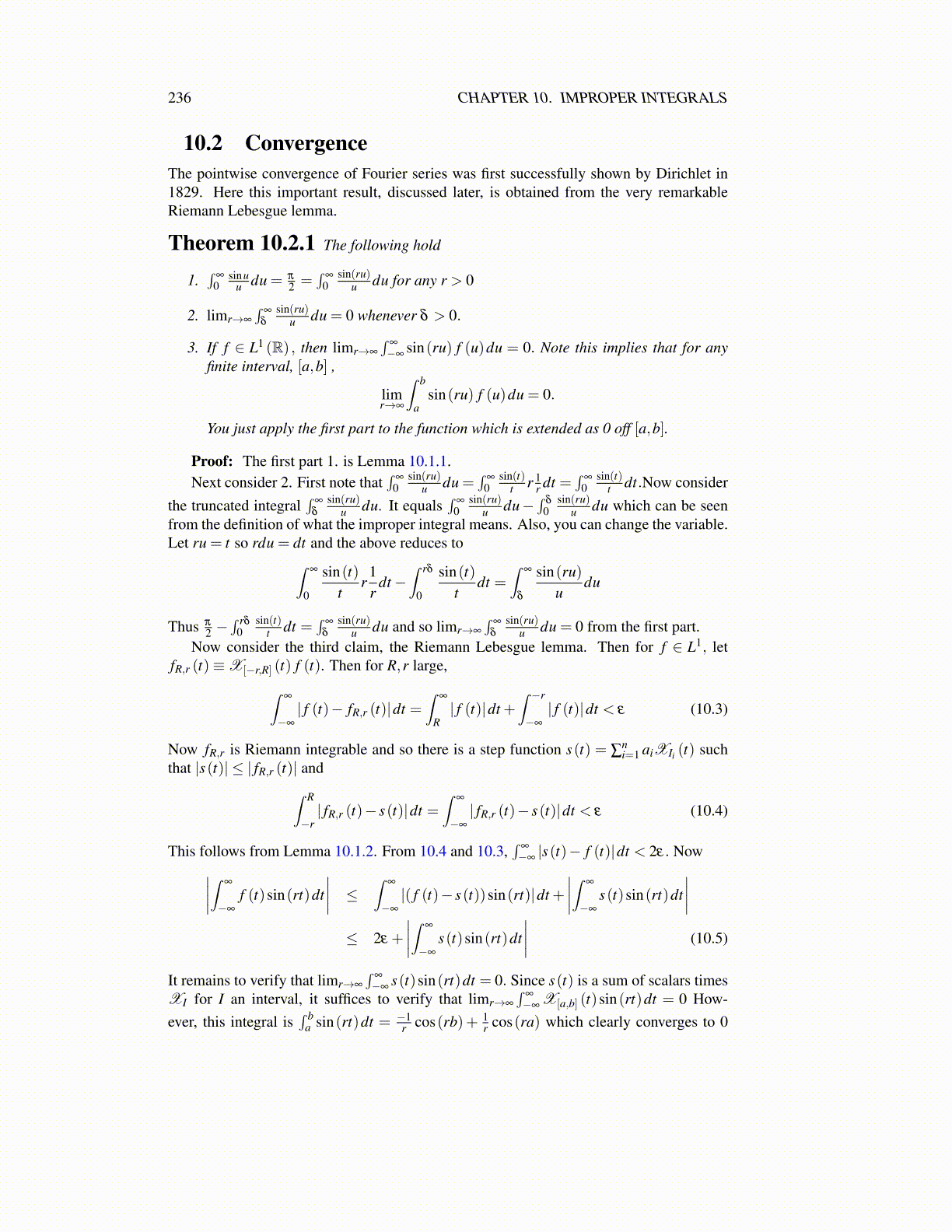
236 CHAPTER 10. IMPROPER INTEGRALS
+2π
∫∞
δ
sin(ru)u
f (u)du− 2π
∫∞
δ
sin(ru)u
f (0)du (10.7)
Now f (u)u ∈ L1 (δ ,∞) because
∣∣∣ f (u)u
∣∣∣≤ 1δ| f (u)| and so, by the Riemann Lebesgue lemma,
the first integral of 10.7 converges to 0 as r→ ∞. The second integral of 10.7 convergesto 0 as r→ ∞ because of the second part of Theorem 10.2.1. Now consider the integralin 10.6. s→ f (u)− f (0)
u is in L1 ([0,δ ]) because∣∣∣ f (u)− f (0)
u
∣∣∣ ≤ uγ−1 which has finite integral
since γ > 0. Therefore, limr→∞2π
∫δ
0sin(ru)
u ( f (u)− f (0))du = 0 by the Riemann Lebesguelemma.
Theorem 10.2.5 Suppose that g ∈ L1 (R) and that at some x, g is locally Holdercontinuous from the right and from the left. This means there exist constants K,δ > 0 andr ∈ (0,1] such that for |x− y|< δ ,
|g(x+)−g(y)|< K |x− y|r (10.8)
for y > x and|g(x−)−g(y)|< K |x− y|r (10.9)
for y < x. Then
limr→∞
2π
∫∞
0
sin(ur)u
(g(x−u)+g(x+u)
2
)du =
g(x+)+g(x−)2
.
Proof: The function u→ g(x−u)+g(x+u)2 ≡ f (u) is in L1 (0,∞) as noted earlier. Also for
f (0) defined as g(x+)+g(x−)2 , the conditions of Lemma 10.2.4 are obtained. Therefore, from
that lemma,
limr→∞
2π
∫∞
0
sin(ur)u
f (u)du = limr→∞
2π
∫∞
0
sin(ur)u
(g(x−u)+g(x+u)
2
)du
=g(x+)+g(x−)
2as claimed.
There is an other condition which will allow the same conclusion as the above condi-tion. It is that g is of bounded variation on [x−δ ,x+δ ] for some δ > 0. This is calledthe Jordan condition whereas the more common assumption used above is the Dini condi-tion. This Jordan condition implies that u→ (g(x−u)−g(x−)+g(x+u)−g(x+)) is ofbounded variation on [0,δ ].
First, here is a little review. If H is continuous, Theorem 9.9.1, the mean value theoremfor integrals, implies that if g is monotone, (either increasing or decreasing) then∫ b
aH (x)dg = H (c)(g(b)−g(a))
for some c ∈ [a,b]. Suppose then that H (x) ≡∫ x
a h(t)dt where h is continuous and g ismonotone on [a,b] .
Suppose H (x)≡∫ x
a h(t)dt where h is continuous and g is monotone on [a,b] . Then byintegration by parts, Theorem 9.4.1,
∫ ba gdH +
∫ ba Hdg = g(b)H (b). From the first mean
value theorem for integrals, there is c∈ [a,b] such that∫ b
a Hdg=H (c)(g(b)−g(a)) . Then∫ b
aghdt =
∫ b
agdH =−
∫ b
aHdg+g(b)H (b) =−H (c)(g(b)−g(a))+g(b)H (b)